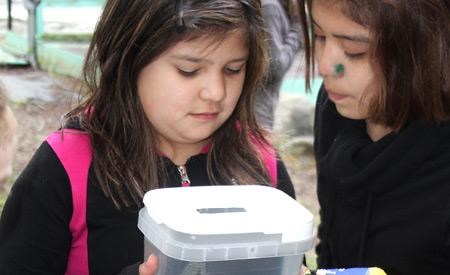VIDEO – Students from all over Powell River recently helped complete the circle of life by releasing salmon fry, which they have been raising in classrooms since January, into Lang Creek.
April Dimond’s grade four class at James Thomson Elementary School took part in the program and received a shipment of coho eggs, about three months after hatching, on January 19. The eggs hatched into fry over the February 19 to 20 weekend after being kept in a temperature-controlled aquarium, covered from the light in the back of the classroom.
This is Dimond’s fourth year having the program in her classroom and she said she is learning something too. Each year her survival rate for the fry is improving. The class received 30 eggs this year. Only one didn’t hatch and another died in the tank. The rest hatched into healthy fry, ready to face the world.
During the incubation period, students learn about the lifecycle of salmon and its importance to the ecosystem and to the culture of the Tla’Amin (Sliammon) First Nation people. They also learn about different types of salmon and the anatomy of fish during a dissection the students watched.
“It’s nice because they get to see the whole process,” said Dimond. “We look at the environmental effects, the sustainability, the culture connections and the development to see how environments affect the fish.”
“Well, you don’t kill too many,” said James Forster, grade five, on what he learned about sustaining salmon populations. “Can’t put garbage in the ocean. Don’t put too much food in the tank or they’ll eat to death.”
The program is coordinated in part by Diane Sanford, Fisheries and Oceans Canada education contractor, who met with the students at Lang Creek to talk to them about what is coming next for their aquatic friends and why the work they are doing is important.
Other classes from other schools came to Lang Creek Salmon Hatchery after James Thomson to release their own fry into the creek and wish them well on the next stage of their journey. The students watched the salmon they had raised being released into the creek before each student released an older fish of their own, provided by the hatchery. They also learned about the bugs that salmon feed on and inspected tubs of creek sediment with magnifying glasses to search for and identify bugs.
The hardest part of the salmon’s life starts now, after being released into the creek, where they will have to battle the elements and predators in order to grow into full-sized fish and start the spawning process all over again. With the good start they’ve received from School District 47 students their odds of survival have already been greatly increased.



